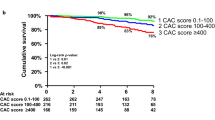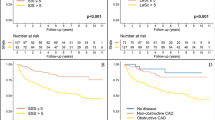Abstract
There is little data regarding coronary artery disease (CAD) and/or atherosclerotic plaques on coronary computed tomographic angiography (CCTA) among the elderly and its outcome, especially in asymptomatic patients. Using CCTA, we evaluated the prevalence and extent of CAD and/or atherosclerosis and related outcomes in asymptomatic elderly patients as compared with symptomatic elderly patients. The study included 1,196 consecutive patients aged 70 years or older who underwent CCTA over a 2-year period. Data were retrospectively evaluated for clinical cardiovascular risk factors with co-morbidities, and CCTA findings, including calcium scores, atherosclerotic plaques (number, plaque-segment score, plaque-extent score, and plaque-significant score) and presence of significant CAD. Follow-up data for active management and all-cause mortality after CCTA were collected for 2 years. Two-sided Student’s t test for independent samples, Chi square contingency tables, and Kaplan–Meier survival curves were used for statistical analysis. Data for 454 asymptomatic and 742 symptomatic elderly patients were analyzed. The prevalence of significant CAD and the extent of atherosclerotic plaques did not differ between the two groups (all P > 0.05). Asymptomatic patients with significant CAD on CCTA, were less likely to receive active management (P < 0.001), which may be related to the higher death rate in this group (P = 0.012) than in the symptomatic patients with significant CAD. Overall, symptoms were not related to the presence of significant CAD or to the extent of atherosclerosis in these elderly patients. However, all-cause mortality was higher in the asymptomatic patients with significant CAD than in the symptomatic ones.


Similar content being viewed by others
References
Kattainen A, Salomaa V, Harkanen T et al (2006) Coronary heart disease: from a disease of middle-aged men in the late 1970s to a disease of elderly women in the 2000s. Eur Heart J 27(3):296–301
Kannel WB, Vokonas PS (1992) Demographics of the prevalence, incidence, and management of coronary heart disease in the elderly and in women. Ann Epidemiol 2(1–2):5–14
Murray CJ, Lopez AD (1997) Mortality by cause for eight regions of the world: global burden of disease study. Lancet 349(9061):1269–1276
Caird FI (1963) Heart disease in old age. Postgrad Med J 39:408–420
Williams MA, Fleg JL, Ades PA et al (2002) Secondary prevention of coronary heart disease in the elderly (with emphasis on patients ≥75 years of age): an American heart association scientific statement from the council on clinical cardiology subcommittee on exercise, cardiac rehabilitation, and prevention. Circulation 105(14):1735–1743
Bilquis Shabbir AMK, Nazir ASMA, Hussain S, Qaisera S (2004) Coronary artery disease in elderly patients. Biomedica 20:36–39
Tervahauta M, Pekkanen J, Kivinen P et al (1993) Prevalence of coronary heart disease and associated risk factors among elderly Finnish men in the seven countries study. Atherosclerosis 104(1–2):47–59
Vanhoenacker PK, Heijenbrok-Kal MH, Van Heste R et al (2007) Diagnostic performance of multidetector CT angiography for assessment of coronary artery disease: meta-analysis. Radiology 244(2):419–428
Hamon M, Morello R, Riddell JW (2007) Coronary arteries: diagnostic performance of 16-versus 64-section spiral CT compared with invasive coronary angiography—meta-analysis. Radiology 245(3):720–731
Cheng VY, Lepor NE, Madyoon H, Eshaghian S, Naraghi AL, Shah PK (2007) Presence and severity of noncalcified coronary plaque on 64-slice computed tomographic coronary angiography in patients with zero and low coronary artery calcium. Am J Cardiol 99(9):1183–1186
Leber AW, Becker A, Knez A et al (2006) Accuracy of 64-slice computed tomography to classify and quantify plaque volumes in the proximal coronary system: a comparative study using intravascular ultrasound. J Am Coll Cardiol 47(3):672–677
Hamon M, Biondi-Zoccai GG, Malagutti P, Agostoni P, Morello R, Valgimigli M (2006) Diagnostic performance of multislice spiral computed tomography of coronary arteries as compared with conventional invasive coronary angiography: a meta-analysis. J Am Coll Cardiol 48(9):1896–1910
Gibbons RJ, Balady GJ, Beasley JW et al (1997) ACC/AHA guidelines for exercise testing: executive summary. A report of the American college of Cardiology/American heart association task force on practice guidelines (committee on exercise testing). Circulation 96(1):345–354
Boden WE, O’Rourke RA, Teo KK et al (2007) Optimal medical therapy with or without PCI for stable coronary disease. N Engl J Med 356(15):1503–1516
Agatston AS, Janowitz WR, Hildner FJ, Zusmer NR, Viamonte M Jr, Detrano R (1990) Quantification of coronary artery calcium using ultrafast computed tomography. J Am Coll Cardiol 15(4):827–832
Austen WG, Edwards JE, Frye RL et al (1975) A reporting system on patients evaluated for coronary artery disease. Report of the ad hoc committee for grading of coronary artery disease, council on cardiovascular surgery, American heart association. Circulation 51(4 Suppl):5–40
Johnson KM, Dowe DA, Brink JA (2009) Traditional clinical risk assessment tools do not accurately predict coronary atherosclerotic plaque burden: a CT angiography study. AJR Am J Roentgenol 192(1):235–243
Merkouris A, Apostolakis E, Pistolas D, Papagiannaki V, Diakomopoulou E, Patiraki E (2009) Quality of life after coronary artery bypass graft surgery in the elderly. Eur J Cardiovasc Nurs 8(1):74–81
Lim HS, Farouque O, Andrianopoulos N et al (2009) Survival of elderly patients undergoing percutaneous coronary intervention for acute myocardial infarction complicated by cardiogenic shock. JACC Cardiovasc Interv 2(2):146–152
Graham MM, Ghali WA, Faris PD, Galbraith PD, Norris CM, Knudtson ML (2002) Survival after coronary revascularization in the elderly. Circulation 105(20):2378–2384
Teo KK, Sedlis SP, Boden WE et al (2009) Optimal medical therapy with or without percutaneous coronary intervention in older patients with stable coronary disease: a pre-specified subset analysis of the COURAGE (Clinical Outcomes Utilizing Revascularization and Aggressive druG Evaluation) trial. J Am Coll Cardiol 54(14):1303–1308
Pfisterer M, Buser P, Osswald S et al (2003) Outcome of elderly patients with chronic symptomatic coronary artery disease with an invasive versus optimized medical treatment strategy: one-year results of the randomized TIME trial. JAMA 289(9):1117–1123
Enbergs A, Burger R, Reinecke H, Borggrefe M, Breithardt G, Kerber S (2000) Prevalence of coronary artery disease in a general population without suspicion of coronary artery disease: angiographic analysis of subjects aged 40–70 years referred for catheter ablation therapy. Eur Heart J 21(1):45–52
Friesinger GO (1995) Coronary angiography in octogenarians: problems and possibilities. Am J Med 99(1):13–15
Acknowledgments
This study was supported by a new faculty research seed money grant of Yonsei University College of Medicine for 8-2012-0074
Conflict of interest
None.
Author information
Authors and Affiliations
Corresponding author
Rights and permissions
About this article
Cite this article
Lee, HJ., Kim, Y.J., Hur, J. et al. Prevalence and extent of atherosclerotic coronary artery disease and related outcome based on coronary computed tomographic angiography in asymptomatic elderly patients: retrospective cohort study. Int J Cardiovasc Imaging 30, 669–676 (2014). https://doi.org/10.1007/s10554-014-0366-3
Received:
Accepted:
Published:
Issue Date:
DOI: https://doi.org/10.1007/s10554-014-0366-3




